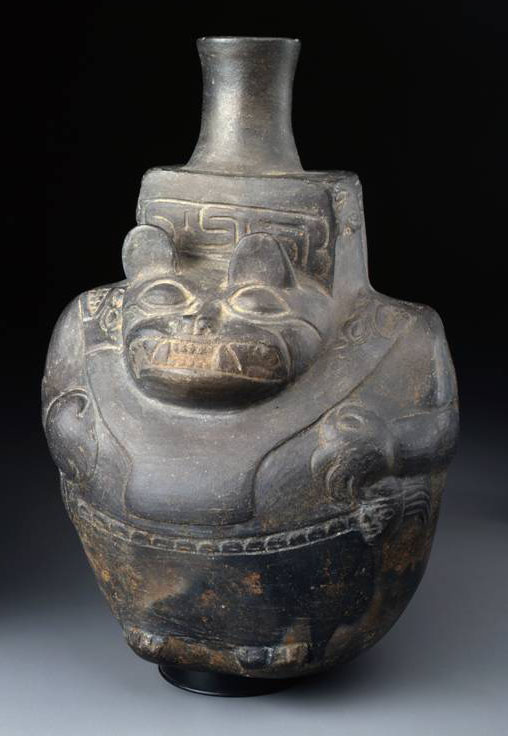“I began to move on all fours…As I moved, I felt power, the power of long sinews, of powerful muscles stretching and contracting, of four paws solidly connected to the earth, of blackness of sleekness, and of shininess. I felt the power of the black jaguar…with the ability to explode into movement, leaping, running, charging…” -Anonymous
Though less familiar than the tawny spotted jaguar, the black jaguar does exist, its inky spots making only a slight contrast to its black pelt. Such a feline is almost entirely invisible at night and therefore even more frightening to its animal prey and to humans than its tawny counterpart. Ancient American artists were well aware of the black jaguar and immortalized it from the central coast of Peru to northwestern Costa Rica. They combined it with the human form in both obvious and subtle ways, communicating that extremely powerful shamans turn into black jaguars during visions. Cat and person are presented as one and the same being, as the Taulipang spiritual leader announces in saying “for I am the black jaguar.”

Vessel in the Form of a Feline-Headed Decapitator South America, Central Andes, Central-North Coast. Middle Horizon, ca. 750 AD. Ceramic. 1989.8.160. Gift of William C. and Carol W. Thibadeau. Photo by Michael McKelvey.
The Andean piece gives a jaguar head and talons to a standing man holding a severed human head. The crossed canine fangs and round ears are telltale attributes of this largest feline in the Americas, yet the almond-shaped eyes are obviously human, indicating the shaman’s dual transformative nature. Jaguars will kill humans when pressed, and do so by crushing their skulls, but will not eat them; in the work of art it is the head of an enemy that is similarly taken and displayed, not ingested. The violent nature of shamanic battles with malevolent spirits, diseases, and other shamans parallels both natural predation and human warfare.

Globular Vessel with Incised and Modeled Black Jaguar-Shaman Motifs Central America, Greater Nicoya, Costa Rica. Belen Incised, Palmares Variety. Period V-Period VI, 800-1350 AD. Ceramic. 1991.4.311. Ex. coll. William C. and Carol W. Thibadeau. Photo by Bruce M. White, 2008.
The Costa Rican vessel also includes the human almond eyes, this time in a wholly jaguar body. By carving them into the surface the artist has emphasized the shadowy spots on the black body, and the pot itself echoes the blackness of night. Creatively distorting reality, the artist has made the most dangerous parts of the jaguar, the head and the claws, protrude in a subtly menacing way. Between this jaguar and the fully three-dimensional one on the other side of the piece the beautifully incised twisted vine refers to Banisteriopsis inebrians, a powerful entheogen native to Costa Rica.
